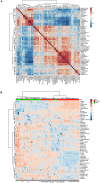Metabolomic Profiling Revealed Potential Biomarkers in Patients With Moyamoya Disease
- PMID: 32372905
- PMCID: PMC7186471
- DOI: 10.3389/fnins.2020.00308
Metabolomic Profiling Revealed Potential Biomarkers in Patients With Moyamoya Disease
Abstract
Metabolomics is increasingly used to observe metabolic patterns and disease-specific metabolic biomarkers. However, serum metabolite analysis of moyamoya disease (MMD) is rarely reported. We investigated serum metabolites in MMD and compared them with those of healthy controls (HCs) using a non-targeted gas chromatography-mass spectrometry (GC-MS) approach to identify metabolic biomarkers associated with MMD. Forty-one patients with MMD diagnosed by cerebral angiography and 58 HCs were recruited for our study. Comparative analyses (univariate, multivariate, correlation, heatmaps, receiver operating characteristi curves) were performed between MMD patients and HCs. Twenty-five discriminating serum metabolic biomarkers between MMD patients and HCs were identified. Compared with HCs, MMD patients had higher levels of phenol, 2-hydroxybutyric acid, L-isoleucine, L-serine, glycerol, pelargonic acid, L-methionine, myristic acid, pyroglutamic acid, palmitic acid, palmitoleic acid, stearic acid, octadecanamide, monoglyceride (MG) (16:0/0:0/0:0), and MG (0:0/18:0/0:0), and lower levels of L-alanine, L-valine, urea, succinic acid, L-phenylalanine, L-threonine, L-tyrosine, edetic acid, and oleamide. These metabolic biomarkers are involved in several pathways and are closely associated with the metabolism of amino acids, lipids, carbohydrates, and carbohydrate translation. A GC-MS-based metabolomics approach could be useful in the clinical diagnosis of MMD. The identified biomarkers may be helpful to develop an objective diagnostic method for MMD and improve our understanding of MMD pathogenesis.
Keywords: biomarkers; gas chromatography–mass spectrometry; metabolomics; moyamoya disease; serum.
Copyright © 2020 Geng, Cui, Guo, Wang, Zhang, Han, Jin, Chen and Jiang.
Figures





Similar articles
-
Targeted metabolomics analysis of serum amino acid profiles in patients with Moyamoya disease.Amino Acids. 2022 Jan;54(1):137-146. doi: 10.1007/s00726-021-03100-w. Epub 2021 Nov 20. Amino Acids. 2022. PMID: 34800175
-
Liquid chromatography coupled to mass spectrometry metabolomic analysis of cerebrospinal fluid revealed the metabolic characteristics of moyamoya disease.Front Neurol. 2024 Feb 15;15:1298385. doi: 10.3389/fneur.2024.1298385. eCollection 2024. Front Neurol. 2024. PMID: 38426176 Free PMC article.
-
1H-NMR-based metabolomic analysis of cerebrospinal fluid from adult bilateral moyamoya disease: comparison with unilateral moyamoya disease and atherosclerotic stenosis.Medicine (Baltimore). 2015 May;94(17):e629. doi: 10.1097/MD.0000000000000629. Medicine (Baltimore). 2015. PMID: 25929894 Free PMC article.
-
Identification of Biomarkers for Preeclampsia Based on Metabolomics.Clin Epidemiol. 2022 Mar 19;14:337-360. doi: 10.2147/CLEP.S353019. eCollection 2022. Clin Epidemiol. 2022. PMID: 35342309 Free PMC article. Review.
-
Moyamoya Biomarkers.J Korean Neurosurg Soc. 2015 Jun;57(6):415-21. doi: 10.3340/jkns.2015.57.6.415. Epub 2015 Jun 30. J Korean Neurosurg Soc. 2015. PMID: 26180608 Free PMC article. Review.
Cited by
-
Comprehensive Serum Proteomic and Metabolomic Profiles of Pediatric Patients with Moyamoya Disease Reveal Core Pathways.J Inflamm Res. 2024 Sep 9;17:6173-6192. doi: 10.2147/JIR.S471538. eCollection 2024. J Inflamm Res. 2024. PMID: 39281778 Free PMC article.
-
Advances in moyamoya disease: pathogenesis, diagnosis, and therapeutic interventions.MedComm (2020). 2025 Jan 14;6(2):e70054. doi: 10.1002/mco2.70054. eCollection 2025 Feb. MedComm (2020). 2025. PMID: 39822761 Free PMC article. Review.
-
Vascular Remodeling in Moyamoya Angiopathy: From Peripheral Blood Mononuclear Cells to Endothelial Cells.Int J Mol Sci. 2020 Aug 11;21(16):5763. doi: 10.3390/ijms21165763. Int J Mol Sci. 2020. PMID: 32796702 Free PMC article.
-
Novel Multifaceted Roles for RNF213 Protein.Int J Mol Sci. 2022 Apr 19;23(9):4492. doi: 10.3390/ijms23094492. Int J Mol Sci. 2022. PMID: 35562882 Free PMC article. Review.
-
Plasma urea cycle metabolite levels and the risk of moyamoya disease.Front Neurosci. 2023 Jul 10;17:1163733. doi: 10.3389/fnins.2023.1163733. eCollection 2023. Front Neurosci. 2023. PMID: 37492403 Free PMC article.
References
-
- Bechthold I., Bretz K., Kabasci S., Kopitzky R., Springer A. (2010). Succinic acid: anew platform chemical for biobased polymers from renewable resources. Chem. Eng. Technol. 31 647–654. 10.1002/ceat.200800063 - DOI
-
- Chen H. Y., Fang S., Wang L. (2017). Interactions of 1-butyl-2,3-dimethylimidazolium bromide ionic liquid with glycine, l -alanine and l -valine: a volumetric and NMR spectroscopic study. J. Mol. Liq. 225 706–712. 10.1016/j.molliq.2016.10.125 - DOI
LinkOut - more resources
Full Text Sources
Miscellaneous

